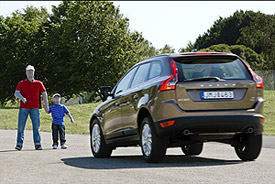 We’re often told to “think outside the box” and while the days of the boxy yellow Volvo have just about faded the engineers at Volvo are now thinking beyond the car when it comes to safety. New technology already being tested on the streets is aimed at keeping pedestrians safe … at least if it’s a Volvo that could be about to run them down.
We’re often told to “think outside the box” and while the days of the boxy yellow Volvo have just about faded the engineers at Volvo are now thinking beyond the car when it comes to safety. New technology already being tested on the streets is aimed at keeping pedestrians safe … at least if it’s a Volvo that could be about to run them down.
The new technology – Collision Warning with Full Auto Brake and Pedestrian Detection – will be introduced together with the all-new Volvo S60 in 2010. Volvo Cars’ safety experts have been working with Pedestrian Detection technology for ten years and test cars have been rolling all over the world – most recently in the busy streets of Copenhagen.
“Factors like traffic behaviour, road conditions and climate must be taken into account in the design of the final system. All told we have collected more than 500,000 kilometres of real-life data. We can also use the information from these traffic tests to conduct advanced computer simulations,” says Thomas Broberg, Senior Safety Advisor at Volvo Cars.
The new safety functions in Collision Warning with Full Auto Brake and Pedestrian Detection represent the next stage in Volvo Cars’ continuous development of technology to detect risky situations and help the driver mitigate or avoid accidents by providing support in the decision-making process.
“The previous stages were developed to help the driver avoid collisions with other vehicles.
Now we are taking a giant step forward with a function that also boosts safety for unprotected road-users. What is more, we are advancing from fifty percent to full automatic braking power. To the best of our knowledge, none of our competitors have made such progress in this area,” explains Thomas Broberg. He adds:
“This technology helps us take an important step towards our long-term vision of designing cars that do not crash. Our aim for 2020 is that no-one should be killed or seriously injured in a Volvo.”
Collision Warning with Full Auto Brake and Pedestrian Safety consists of a new dual-mode radar unit integrated into the car’s grille, a camera behind the inside rear-view mirror and a central control unit. The radar and camera continuously monitor the road in front of the car. The radar’s task is to detect objects and measure the distance to them. The camera determines what type of objects they are.
In an emergency situation, the driver is first alerted by an audible warning together with a flashing light in the windscreen’s head-up display. In order to prompt an immediate, intuitive reaction, the visual warning is designed to look like a brake light coming on. If the driver does not respond to the warning and the system assesses that a collision is imminent, the car’s brakes are applied with full braking power.
“Active brake deployment requires that the object is confirmed by both the radar and the camera. Thanks to state-of-the-art sensor technology, it is now possible to engage full braking power,” explains Thomas Broberg.